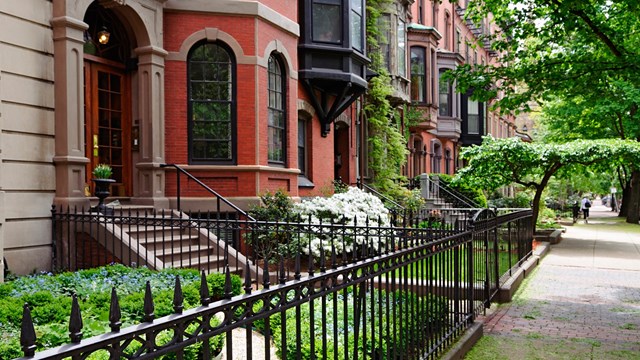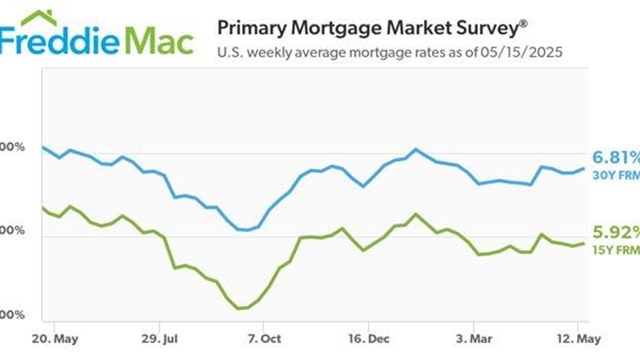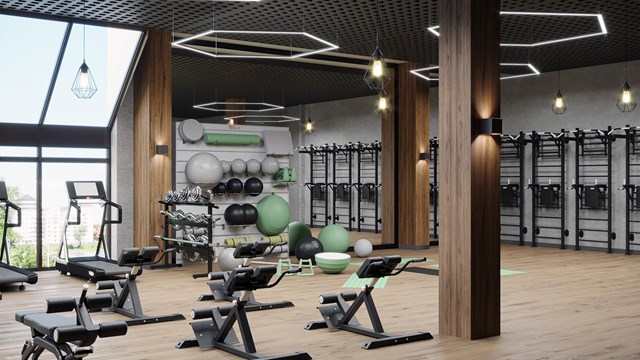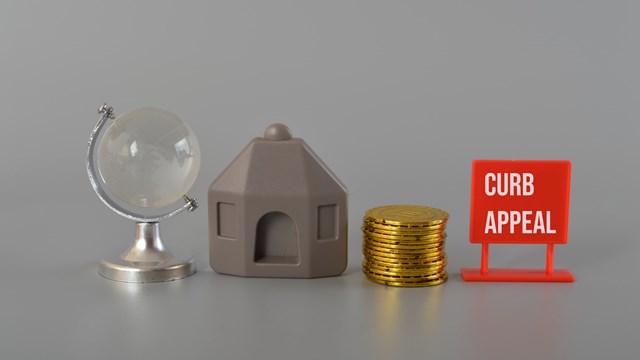What sells a condo or co-op unit? Is it the feel of the space (and the building it’s in), the light, or the layout? Is it the price alone? The realtor’s mantra of ‘location, location, location’? Or something else entirely? Maybe a feeling of ‘hominess’ that calls out to the buyer: This is where you belong! Or perhaps it’s all of these, plus many more factors.
Across the board, brokers and managers agree that when a prospective buyer finds the right space, it just clicks. A combination of exterior curb appeal, well-kept common areas, and smart staging of the unit itself can make that ‘click’ happen from the moment a home-hunter sees the building, and help maximize the final sales price of the property.
Before You Cross the Threshold
Studies have shown that curb appeal (or lack thereof) can significantly impact individual unit sales prices within a building or HOA, to the tune of 5 to 10 percent up or down, depending. Buyers form an opinion within seconds upon seeing the building exterior and common areas
Which is why, according to Scott Wolf, CEO of BRIGS, a property management company based in Boston, the most basic, fundamental component in curb appeal is neatness—both inside and out. “The first emphasis should be on cleanliness,” he says. “When you enter a property, whether it be an apartment building in an urban setting or a more suburban townhouse community, you want to have something that makes for comfort. You are addressing the five senses; a fresh scent, for instance. Planters outside are always attractive, but the first factor is always cleanliness. Making sure glass is always clean, all the lights are working. You want the same color and kind of light bulbs throughout the space. If one bulb is white light and the other yellow, the effect is not good. Mailboxes should be uniform with uniform labels—not taped paper. These things should be nice, consistent, and uniform. It may seem minor, but it’s important.”
Well-manicured landscaping, clean walkways, maintained roadways and curbing, state-of-the-art amenities, and a welcoming entrance all signal a well-managed and desirable property, and give the perception of value. High curb appeal indicates a pride of ownership and investment in the community, leading buyers to perceive units and homes as more valuable.
“We can’t definitively say exactly how much unit price is affected by curb appeal more broadly,” Wolf says, “but lack of curb appeal will definitely negatively impact it. Buyers will look for properties with a better overall welcoming appearance. They don’t worry about aging elevators or boilers like board members do; they look at the appearance of the building—they think, ‘What will my friends think when they come to visit where I live?’”
The Inner Sanctum
Even if our building has a sleek, modern lobby that’s immaculately clean and clutter-free, most of us would have to admit that our actual apartments don’t look like model units in brand-new residential developments. Whether our taste is eclectic maximalism, sophisticated minimalism, or something in between, most abodes have that ‘lived-in’ look, with photos, artwork, tchotchkes, and all the other personal touches that make a house a home—your home. But while a buyer may want your space, they don’t necessarily want your home. That’s where the staging process comes in.
“The value of staging is that homes will sell faster and for more money,” says Amanda Wiss, the founder of Urban Clarity, a Brooklyn, New York-based company specializing in space optimization and organization, “In our experience, we’ve found that apartments we’ve staged typically sell quickly, and for over the asking price. It’s not unusual to have multiple bids on staged apartments because they tend to get more attention based on the images in the listing, plus word-of-mouth buzz.”
Some sellers instinctively understand the value of staging. “The owners who are hesitant usually think it’s a superfluous expense,” says Wiss. “In that case, we explain that the longer the home is on the market, the greater the carrying costs. And prospective buyers don’t always understand how a completely empty space can ultimately be laid out, so staging really helps them see what their life could be in the space.”
According to Elisha Lynch, a realtor with Lamacchia Realty in Worcester, Massachusetts, “Staging needs depend on the property. If you have a vacant high-end property, visualization is difficult for many buyers, and staging provides a homey environment. It’s especially important in unique layouts.” When the unit for sale is occupied, says Lynch, “At a minimum, sellers should depersonalize, deep clean, and tidy up. There should be a minimal number of personal items around. When someone tours the unit, they need to envision their family there, not yours.”
Wiss agrees. “The aim of staging is to de-personalize the space,” she says. “The prospective buyer should be able to imagine themselves living and thriving in the space. The owner should take out all their most personal items, like family photos, children’s artwork, trophies, and refrigerator magnets. You also don’t want to have an entryway cluttered with the family’s shoes, boots, coats, umbrellas, etc. We want to free up as many common areas as possible, and clear tabletops and surfaces. You should be able to see the floor in every closet. Also, bright fluorescent light bulbs kill the ambience and should always be replaced with warm, golden light.”
Levels of Staging
A broker’s wish list for the easiest-sale-ever may well include a totally vacant, freshly renovated, just-painted unit filled with tastefully nondescript rental furnishings, but the price tag for that convenience can be prohibitive for many sellers. After all, most of us need to live in our homes until we sell them. With that consideration in mind, are there ways to stage on a budget?
“There are instances where the bare bones of a property are problematic,” says Wiss. “Sometimes you can make a real difference with staging despite harsh limitations, but sometimes it’s best to just recommend a thorough cleaning out of the clutter, a fresh paint job, and the most simple and minimal furnishings and lighting changes.” That said, she continues, “I can’t think of a time where absolutely nothing could be done. Even homes that go on the market as complete gut renovations can benefit from fresh paint, new lighting, decluttering, and depersonalization, as well as room-appropriate furnishings, plants, and artwork.”
Techniques
When preparing a property to list, stagers take into consideration the bare bones of the space: when it was built, its location, ceiling height, windows, flooring, etc. Smart staging almost always employs a neutral palette, occasionally adding color and texture as accents, and adjusting light and shadow through the thoughtful choice and placement of décor, furniture, fabric, and art. Lighting is also extremely important. Lighting points at different heights and angles create warmth, and can delineate different spaces within the home. Stagers often bring in organic elements like budding branches, flowering plants, and greenery—even artificial ones—to help cultivate a soothing, desirable environment. Rugs and wall art are also often used to grab potential buyers’ attention, as well as making for more appealing images for online listings.
According to Lynch, “Repainting is one of the cheapest returns on investment available and gives a nice, clean look. You don’t want to invest where you won’t see a return—so replacing an entire kitchen that’s not what the buyer wants may not be worth it. They will do that themselves. We always discuss with sellers exactly what they should and need to do to stage properly.”
Going Virtual
Brokers and professional stagers have been working their magic for years, but the ubiquity of online real estate listings has coincided with ‘virtual staging’—staging literally done through photo editing or, even more recently, AI. In addition to the expense of physical staging, there are any number of reasons a seller might not be able to stage (or even vacate) a home for showings. A family with small children, for example, or a person with mobility limitations might not be a candidate for a full staging—but with an accurate floor plan and some fairly basic tech, their unit can be transformed—at least for its online listing—without moving a single chair.
“Virtual staging digitally changes the appearance of the unit,” says Nigel Pearce, a broker associated with Compass based in New York. “We use it when we have a seller who can’t or won’t restage or repaint, etc. We can change wall color, cabinets, furniture. We can make the space look any way we want. We can even declutter it from an original picture. We can also use virtual staging when an apartment is empty, to give potential buyers an idea to visualize what the space could be transformed into. In a case where a unit requires a total gut job, we can make it look brand new. It’s economical. I had a client where I got a lot of views of the online listing, but no response for viewings. Once we did a virtual staging, we got a flood of viewers and it got sold.”
Real estate pros pitch staging as a way to improve a seller’s market position, especially when the market is tight. It helps the buyers envision how their furniture might fit into their new home, helps them visualize potential layouts, and basically gets their imagination going. Staging is also especially important now, with large numbers of people still working from home in the post-pandemic era.
And, says Wiss, “The principles of staging remain the same in a hot ‘seller’s’ market environment as they do in a period that is more a ‘buyer’s’ market. Keep in mind that prospective buyers are looking at many places, so the ones that stick out in their mind at the end of the day, and require the least amount of imagination on their part, are the properties that are going to move faster. There is no reason to change the winning recipe.”
Cooper Smith is a staff writer/reporter for New England Condominium.










Leave a Comment